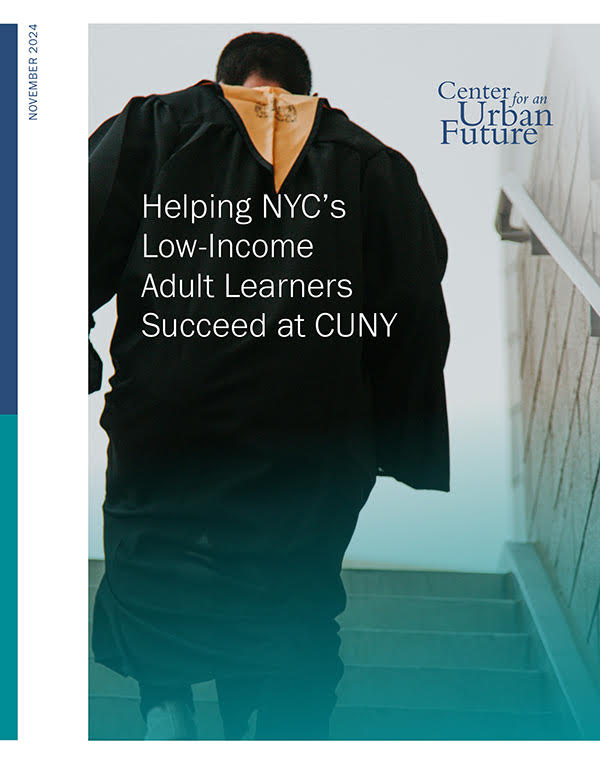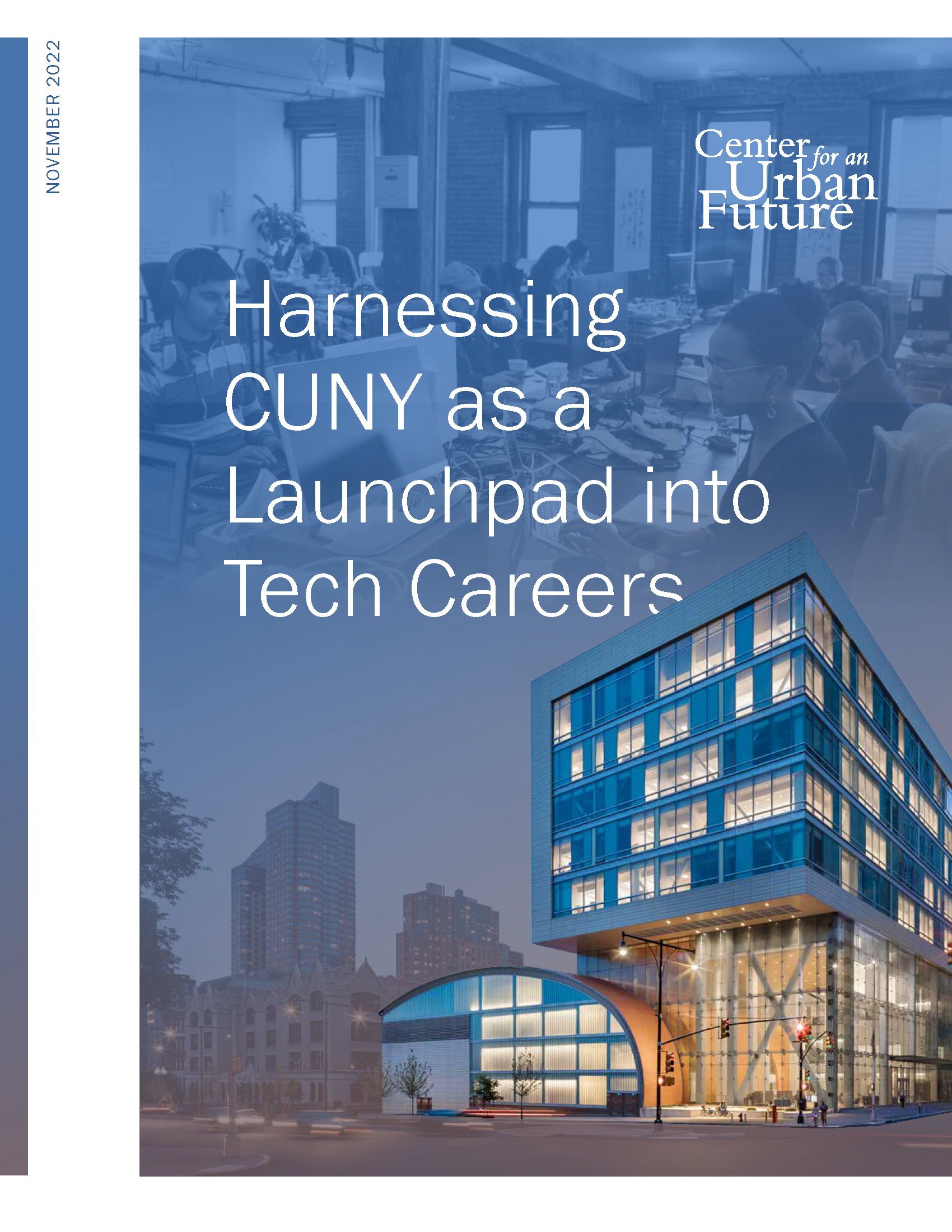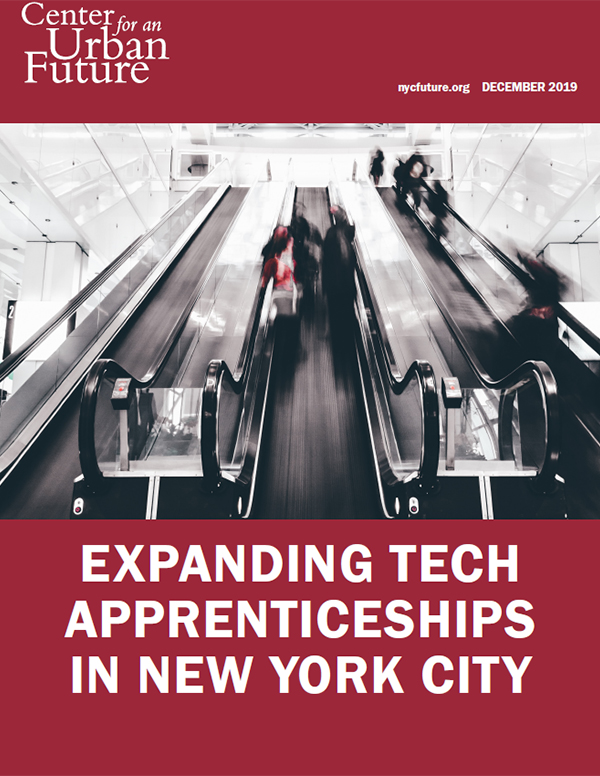It was notable that in the opening minutes of Mayor Eric Adams's State of the City speech this January, the second new policy proposal he outlined was focused not on top-of-news issues, like public safety or homelessness, but rather on expanding the city’s CUNY 2X Tech initiative. Although not well known, even among policymakers, CUNY 2X Tech—a multi-pronged initiative that helps CUNY students prepare for careers in the tech sector—is an ideal starting point for making progress on a key goal of the mayor’s Working People’s Agenda: to close the troubling unemployment gap between Black and white New Yorkers and to “make sure that all New Yorkers finally have access to good jobs.”
Mayor Adams’s plan to expand CUNY 2X Tech is a logical response to a long-standing problem: too few CUNY students have been obtaining well-paying jobs in New York City’s fast-growing tech sector. Indeed, the growing number of CUNY students who graduate with computer science and other technology degrees are still struggling to break into tech careers. Fortunately, CUNY 2X Tech has been changing this equation.
Three key programs launched or supported by CUNY 2X Tech have had remarkable success helping CUNY graduates break into the industry:
- Students participating in the Tech Talent Pipeline Residency internship program are three times more likely than their peers to land a job upon graduation. The program, which helps students prepare for and land competitive internships at tech companies, is crucial at CUNY, where just one-in-ten students reports having a paid internship.
- CUNY students who take classes taught by industry professionals through the Tech in Residence Corps are four times as likely to secure an internship and twice as likely to get a job in the tech industry. Through the program, tech industry leaders are invited to teach courses that immerse students in cutting-edge industry knowledge.
- 75 percent of students participating in CUNY Tech Prep land a job or internship within five months of finishing the program, which helps technology majors build the skills that employers are looking for while preparing to ace the technical interviews that are typically required for tech jobs.1
.png)
.png)
No other initiative has been as successful at launching CUNY students into the tech industry. But funding for the program—which was initially launched as a five-year, $20 million initiative through the city’s Tech Talent Pipeline (TTP)—expired in 2022, after reaching only a fraction of CUNY’s technology students.
To date, CUNY 2X Tech has reached just seven of the 25 CUNY colleges—with no community colleges served and the notable absence of New York City College of Technology (City Tech), which enrolls more technology majors than any other college in the system.2 The initiative’s key programs remain strikingly small scale, serving fewer than 1,400 students a year across all campuses, primarily due to limited funding and an array of competing demands. The TTP Residency internship has only served about 750 students across seven colleges over the past five years. The Tech in Residence Corps only has the capacity to teach about 500 students per semester. And just 170 students per year are able to participate in CUNY Tech Prep.
In the weeks and months ahead, city leaders should take the steps needed not only to realize Mayor Adams’ vision for expanding CUNY 2X Tech by bringing it to additional campuses, but also to ensure that CUNY’s initial 2X Tech schools are able to maintain their momentum.
If Mayor Adams and the City Council are committed to ensuring that far more New Yorkers can get on the path to well-paying careers, then renewing and expanding CUNY 2X Tech is a crucial place to start. Policymakers should establish a clear goal of bringing the initiative to all 18 primary colleges in the CUNY system over the next five years and allocate $5 million per year to do so; expand the initiative to CUNY’s community colleges and to City Tech, which have not yet benefited from the program; and work with private-sector partners to scale up the key CUNY 2X Tech components that are delivering the best outcomes, including the TTP Residency internship and the Tech-in-Residence Corps. By doing so, city leaders can help thousands more of CUNY’s 175,000 undergraduate students transform technology degrees into careers—and make meaningful progress toward a more equitable economy.
Five Years of CUNY 2X Tech: Strong Outcomes with Room to Grow
In recent years, New York City’s expansive tech sector has emerged as the city’s most reliable source of new middle- and high-wage jobs. The city added more than 119,000 tech jobs over the past decade—growing from 81,000 jobs in 2010 to more than 200,000 in 2022, a 146 percent increase.3
.png)
However, while New York’s tech workforce is more diverse than that of most other major tech hubs, Black and Hispanic New Yorkers remain significantly underrepresented.
Today, Black and Hispanic workers make up 43 percent of New York City’s overall workforce, but hold just one-in-five tech sector jobs.4
No institution is better positioned to help New York make further progress in diversifying the tech workforce than CUNY, where 50 percent of enrolled STEM students are Black and/or Hispanic and approximately 71 percent come from households earning less than $40,000 per year. Indeed, CUNY colleges graduated more Black and Hispanic students with technology degrees in 2019 (1,741) than Columbia University granted total undergraduate degrees in 2021 (1,044).5
Since its inception in 2018, the CUNY 2X Tech initiative has proven effective in doubling the number of CUNY students earning technology degrees each year. Crucially, the initiative evolved over its initial five-year run to focus not only on boosting degree completion, but on enabling participating colleges to provide key supports and programs that are helping graduates get in the door of technology careers, while creating a more diverse and equitable tech sector. The initiative’s focus on career success has been vital for a system in which only 50 percent of all CUNY computer science graduates from 2017 to 2021 were employed within their field of study one year after graduation.6
“CUNY 2X Tech has really elevated the types of jobs that graduates are getting,” says one campus-level program manager, who requested anonymity in order to speak freely about the program. “Instead of getting pretty lousy consultancy jobs, our graduates are now getting [tech] positions in places like Google, Amazon, and some of the big banks and insurance companies.”
Over the past few months, city leaders have taken important steps to leverage CUNY as a launchpad into technology careers—a recognition that expanding access to the technology-powered jobs driving New York City’s employment recovery in the wake of the pandemic is among the most effective steps the city can take to build a more equitable economy. Most recently, Mayor Adams and CUNY announced the launch of the CUNY Tech Equity Initiative in June, a major effort to boost tech students’ career readiness and forge new connections with employers. The city has also supported efforts at CUNY to train future K-12 teachers in computing education through the highly promising CITE program.
To capitalize on this momentum—and strengthen the city’s largest and most inclusive pathway into technology careers—city policymakers should help Mayor Adams fulfill his January commitment by expanding CUNY 2X Tech to additional colleges, while scaling up the initiative’s key programs at every primary college in the CUNY system.
Since launching in 2018 with a $20 million, five-year commitment from then Mayor Bill de Blasio, CUNY 2X Tech has helped colleges across the CUNY system to increase enrollment in technology degree-granting programs, boost the number of students graduating with technology credentials, and help far more students land paid internships and job offers in the city’s fast-growing tech sector. The initiative has also enabled CUNY colleges to add much-needed computer science faculty, at a time when surging computer science enrollment has caused intro classes to balloon to several hundred students each. Likewise, colleges have leveraged 2X Tech funding to add career coaches, recruit tech industry engagement specialists, and hire academic advisors to bring down advising ratios that are as high as 900 to 1 at CUNY’s senior colleges. College administrators also cite a growing need to help lower-income students acquire computers, purchase software, and secure high-speed Internet access at home.
But in each of these areas, the initiative has significant room to grow in order to meet the surging demand for these supports and resources among CUNY students and colleges and strengthen CUNY’s vital role as a launchpad into technology-powered careers.
1. Boosting access to all-important internships in the tech sector.
Perhaps more so than in any other industry, an undergraduate internship is viewed by many firms as an essential prerequisite for employment in the tech sector. This poses an especially serious challenge at CUNY, where just 10 percent of students report ever having a paid internship during their college careers.7 Fortunately, one of the key programs supported by CUNY 2X Tech, the TTP Residency Internship program, is making progress in expanding access to high-quality paid internships for CUNY students pursuing technology degrees.
The TTP Residency Internship program solves several challenges with internship access at CUNY. First, the program provides students with a four-week technical bootcamp that builds career readiness through a mix of hands-on technical training and soft skills development. Participants then transition into a 12-week paid internship, which offers students $20 per hour for 35 hours each week—a wage that enables students to pursue the internship rather than seek out paid work in an unrelated field. The ultimate goal is to place each participant in a tech role, paying at least $65,000 annually within six months of graduation, including software engineering, app development, and cybersecurity.
Before the introduction of the TTP Residency Internship, college officials say that very few technology students were landing internships before graduation, which set them up for failure in the job market. Over the past five years, TTP Residency Internship participants have secured full-time jobs after graduation at rates three times higher than their peers, according to data collected by the Tech Talent Pipeline.
“The level of preparedness is just much higher,” says one CUNY 2X Tech campus lead, who requested anonymity in order to speak candidly about the program. “The level of understanding of what's required for these entry-level jobs is much higher.”
The impact of the TTP Residency Internship program is evident in the increased number of students securing internships during their college years. For example, at Brooklyn College, 29 percent of technology graduates reported participating in an internship before graduating in the year before CUNY 2X Tech was introduced to that campus. By 2022, fully 56 percent of technology graduates reported having an internship before graduating—a 93 percent increase. Similarly, at the College of Staten Island, 30 percent of graduating students had an internship prior to graduating in the year before CUNY 2X Tech was introduced. In 2022, the share of graduating students who had an internship before graduating was 52 percent, a 73 percent increase.8
More than just enabling students to gain internship experience, however, the TTP Residency Internship program is leading to career success. For instance, over the past five years, 21 percent of participating students at Lehman College received employment offers from the companies where they interned, and approximately 80 percent of all participants are currently employed in the tech industry. Hunter College boasts even more impressive outcomes, with 86 percent of participating students now employed in jobs that require a computer science degree, and 82 percent working as software engineers or data analysts.9
Despite these notable achievements, the reach of the TTP Residency Internship program has been extremely limited in scale. Over the past five years, the program has served approximately 750 students across participating CUNY campuses—out of more than 23,000 students enrolled in tech-related degree-granting programs, according to the most recent data available—and has fallen short of meeting demand. At Lehman College, for instance, the program was capped at 25 to 30 students annually, due to funding limitations, while receiving approximately 100 applications per cycle.
“We would love it if every department could run massive TTP Residency program,” says one senior official involved with CUNY’s technology programs, who requested anonymity because they were not authorized to speak publicly about budgetary issues. “But without sustained funding, it’s not going to happen.”
2. Bringing industry expertise and connections into the classroom.
Some tech sector executives say that CUNY students graduating with computer science and other technology degrees have been at a disadvantage in the hiring process because they have had too little hands-on experience with in-demand technologies and too few opportunities to prove that they can apply what they’ve learned in real-world situations. The Tech in Residence Corps has helped to change this by bringing tech sector expertise into the classroom. The Tech in Residence Corps recruits industry professionals into participating colleges to teach elective courses on technology topics and tools that are currently used by companies in the city’s tech sector. By taking these courses, students gain access to knowledge and skills that align with what companies in the industry are using right now, while forging relationships with mid-career professionals who can provide guidance around everything from professional networking opportunities to the latest industry trends. Course offerings include in-demand and highly practical subjects, such as working with artificial intelligence and machine learning, ensuring students are able to connect academic knowledge to industry needs in ways that improve their employability.
“I loved being able to meet with the chair of the college’s computer science department and say, okay, let’s pull from our Tech in Residence Corps—this person has a strong background in data science, now they’re teaching our data science elective course,” says one CUNY 2X Tech campus lead, who requested anonymity in order to speak candidly about the initiative.
According to data collected at the campus level, students who take courses with Tech in Residence Corps instructors not only gain industry-aligned knowledge and skills—they are more likely to secure jobs after graduation. Data suggests that students who took at least one Tech in Residence Corps class are more than four times as likely to secure an internship and nearly twice as likely to secure full-time employment at the time of graduation.
“The Tech in Residence program gave students exposure to industry-led courses and also gave industry people a window into the pool of talent at CUNY,” says one CUNY administrator who requested anonymity as they were not authorized to speak about the program. “And that was the most significant thing, because a lot of companies hired CUNY students out of that program.”
The challenge is that, to date, the initiative has remained small-scale. In total, only about 60 Corps members have been recruited to teach courses, reaching no more than about 500 students per semester—out of 23,000 technology degree-seeking students. At participating colleges, these courses have proven wildly popular. “These were some of the most well attended courses in the program,” says Fendja Larivaux, CUNY 2X Tech program specialist at Brooklyn College.
.png)
With the initial round of CUNY 2X Tech funding ending in 2022, sustaining the Tech in Residence Corps has proven highly challenging. “Now the burden is on computer science departments to maintain the program’s elements,” says the leader of CUNY 2X Tech programs at one senior college, who requested anonymity in order to speak freely. However, with soaring workloads for current CUNY computer science faculty and far fewer direct connections to industry, it’s unlikely that the outcomes produced by the Tech in Residence Corps can be sustained without continued funding.
3. Keeping pace with the growing need for faculty and staff to support CUNY’s technology degree enrollment boom.
In addition to supporting specific programs that are boosting career outcomes for students, CUNY 2X Tech is also helping colleges keep pace with the boom in technology degree enrollment by adding full-time faculty and staff. From 2010 to 2019—the most recent years for which complete data is available—the number of students pursuing technology majors at CUNY colleges increased by 77 percent, growing from 13,108 to 23,196, even as overall enrollment grew just 5.5 percent.
.png)
Since CUNY 2X Tech launched in 2018, participating colleges have recorded even steeper growth in both enrollment in and graduation from technology degree-granting programs, even as the number of full-time faculty has decreased. For instance, Queens College went from 406 computer science majors and 20 faculty as of 2012, to more than 3,500 majors and just 15 tenure-track faculty as of 2022. Likewise, Hunter College has gone from 85 computer science majors in 2010 to more than 1,600 as of last year, while only adding 13 new faculty, which has resulted in the conversion of every required computer science course into a large lecture with at least 150 students.
As enrollment in computer science at CUNY has increased, the number of faculty employed by CUNY has decreased, dropping from approximately 7,300 full-time faculty in 2020 to about 7,000 in 2023. This has posed particular challenges for CUNY’s computer science departments, where the ratio of students to faculty has surged as high as 142 to 1, according to a college administrator interviewed for this report.
In addition to full-time faculty, experts say that boosting the number of skilled career coaches and academic advisors has proven crucial for improving post-college career outcomes. At the typical CUNY college, there are no more than two or three career counselors for every 10,000 students and ratios of academic advisors to students are upward of 950 to 1, leaving many students struggling to navigate their academic and career paths.
In response, CUNY 2X Tech has enabled colleges to hire a dedicated advisor for computer science students at participating campuses—a support that one administrator called “the best thing to ever happen to that department, and I’ve been there for 30 years.” These hybrid academic advisors and career coaches are succeeding in helping students achieve their career goals. For instance, CUNY computer science graduates who had a full-time advisor were nearly three times (2.81x) more likely to secure an internship than candidates without one.10 Across all colleges that participated in the CUNY 2X Tech initiative, students with a full-time advisor saw the average time to graduation reduced from 5.85 years to 4.2 years.11
.png)
CUNY 2X Tech has also funded faculty lines at colleges with high faculty-student ratios and helped offset the costs of hiring additional advisors, career coaches, and industry engagement specialists.
“We have a high demand, but unfortunately we don't always have the faculty and staff to meet that demand,” says Fendja Larivaux of Brooklyn College “[CUNY 2X Tech allowed us] to provide more faculty so that the student to faculty ratio can be narrowed.” However, she cautioned that without recurring CUNY 2X Tech funding, the college has been unable to sustain “one of the greatest elements of the program”: the full-time advisor position.
4. Preparing students to launch into tech careers.
CUNY Tech Prep is a comprehensive year-long program that equips students with the necessary skills to graduate college and then enter into a tech career. Through career guidance, mentorship, interview preparation, and hands-on code development and deployment, the program supports and supplements the traditional academic experience with learning that is directly applicable to the job market. The program—initially launched before the CUNY 2X Tech initiative—has proven to be instrumental in helping students kickstart their careers in tech, and complements the key initiatives supported under the larger CUNY 2X Tech umbrella.
.png)
Participants of Tech Prep have demonstrated a higher likelihood of landing a job or internship within the crucial months following the program’s completion when compared to their peers, with fully 75 percent of the 150 students enrolled in the program each year secured a job or internship within five months. According to Mike Zamansky, a distinguished lecturer and coordinator of computer science teacher education at Hunter College, the key to Tech Prep’s success is in addressing a significant challenge facing many CUNY technology students: struggles with acing the technical interviews that most tech companies rely on to make hiring decisions. Without a program like Tech Prep, Zamansky says, students “could have careers [in technology-related roles], but may not crack that interview [at a top-tier tech employer].”
Despite the program’s successes, capacity remains very limited, with fewer than 150 students enrolled each academic year. During the 2019-2020 school year, only 125 out of 400 applicants to the Tech Prep program were admitted, with a similar number enrolled in 2021.
The program has succeeded in helping CUNY students—many of whom are the first in their families to attend college, and few of whom have friends or family who already work in the tech sector—to understand how to connect their academic learning to the needs of industry, and make the best possible case for themselves to prospective employers.
“It’s so important to bridge that gap between academics and career preparedness,” says Martha Hantzandreou, the CUNY 2X Tech academic advisor at City College. “Because otherwise, you're in school, you get your degree, and then you wonder, what exactly do I do with it and how do I go about starting my career?”
Recommendations: Expanding pathways into tech careers by growing CUNY 2X Tech
1. Renew funding for the CUNY 2X Tech initiative.
Launched in 2018 as a five-year, $20 million initiative, CUNY 2X Tech has succeeded in boosting the number of CUNY students earning technology degrees and is significantly improving career outcomes. However, the initiative’s funding ran out in 2022 after reaching just a fraction of CUNY’s technology degree-seeking students and having only just begun to take root in the program’s initial seven colleges. Given the striking successes of CUNY 2X Tech, Mayor Adams and the City Council should renew the initiative’s funding for another five years, with the goal of embedding the CUNY 2X Tech approach in all 18 primary colleges in the CUNY system over the next five years. Crucially, this should include funding to bolster the staff capacity of the city's Tech Talent Pipeline to facilitate program expansion. The initiative has also benefited enormously from close partnerships with companies and individuals in the city’s tech sector; Mayor Adams should encourage the city’s tech sector to participate in the next phase of CUNY 2X Tech—whether through funding, technical assistance, and/or participation in the Tech in Residence Corps and the Tech Talent Pipeline Residency internship program.
2. Expand CUNY 2X Tech to all eligible CUNY colleges.
During its initial five-year run, the initiative reached only seven out of the 25 CUNY colleges. To scale its impact across the city, Mayor Adams should expand the initiative to all 18 colleges in the university that maintain a computer science department, with particular emphasis on City Tech, which is home to more technology graduates than any other college in the system. Policymakers should follow through with the mayor’s proposal, outlined in his January 2023 State of the City address, to expand CUNY 2X Tech to at least three community colleges in the coming year, while laying the groundwork for making all 18 primary colleges into CUNY 2X Tech campuses over the next five years.
3. Build CUNY 2X Tech’s most effective initiatives—including the TTP Residency Internship, Tech in Residence Corps, Tech Prep, and hybrid advisor/career coaches—into CUNY’s degree-granting programs.
To ensure that these highly successful programs continue to help CUNY graduates break into technology careers for years to come, Mayor Adams and the City Council should work with CUNY to integrate these crucial initiatives into every college’s degree-granting programs. The city should continue to fund the key staff lines needed for these programs to succeed, including full-time computer science faculty, dedicated career coaches, industry engagement specialists, academic advisors, and the staff of the city’s Tech Talent Pipeline. At the same time, CUNY should work toward embedding the best elements of these effective models into degree-granting programs themselves, such as launching for-credit internship prep courses, requiring students to take classes taught by industry professionals, embedding work-based learning experiences into required classes, and expanding the provision of credit toward a major for students who develop a portfolio of work during the semester. By doing so, CUNY can help replicate the impact of CUNY 2X Tech programs across entire departments and ensure that the positive outcomes can last for years to come.
Endnotes
1 Data collected through interviews with program managers at CUNY’s colleges and the city’s Tech Talent Pipeline.
2 According to interviews with program staff, the initiative is poised to expand next to Baruch, BMCC, City Tech, Guttman, and LaGuardia—but only if sufficient funding is allocated.
3 Center for an Urban Future, New York’s New Jobs Engine, July 2022, https://nycfuture.org/research/new-yorks-new-jobs-engine.
4 Center for an Urban Future, Harnessing CUNY as a Launchpad Into Tech Careers, November 2022, https://nycfuture.org/research/harnessing-cuny-as-a-launchpad-into-tech-careers-report.
5 Ibid.
6 Ibid.
7 Ibid.
8 Data collected through interviews with program managers at CUNY’s colleges and the city’s Tech Talent Pipeline.
9 Ibid.
10 Ibid.
11 Ibid.


.png)
.png)
.png)
.png)
.png)
.png)
.png)







